Investigation of Fracturing Network Propagation in Random Naturally Fractured and Laminated Block Experiments
Abstract
:1. Introduction
2. Laboratory Experiments and Methods
2.1. Model Block Preparation
2.2. Experimental Setup
2.3. Experimental Design
2.4. Research Idea
3. Experimental Observations and Results
3.1. Typical Pump Pressure-Injection Time Curves
3.2. Macroscopic Morphology Observation
3.3. Quantitative Analysis of Fracturing Effectiveness
3.4. Discussion
4. Conclusions
- (1)
- According to the macroscopic failure morphology description, four kinds of typical fracture network geometry are summarized, namely, the radial random net-fractures, main vertical factures with partly branches, partly horizontal fracture with random branches, and main horizontal fractures with partial branches. The geometry of the fracturing network is determined by the studied factors. The effectiveness of fracturing network is best with the radial random net-fractures, and worst with the main horizontal fracture with partial branches.
- (2)
- The hydraulic fractures are prone to communicate with natural fractures under the circumstances of high injection rate and low stress ratio. Laminae strength as a dominant factor, and it is not the case that the lower the strength, the better fracturing effectiveness is. The proposed index of Rm(SRA) can well quantitatively reflect the interaction between hydraulic fracture and natural fractures. Complexity or network fracturing is a combination for establishing main fractures with high conductivity and adding immense contact areas in the rock.
- (3)
- Laminae as a typical geological structure in continental shale hydrocarbons in China, its structure and strength properties strongly influence the propagation of hydraulic fractures. A contrast in material properties at soft-hard interfaces governs the fracture containment, interface slippage can result in the offsetting and arresting behaviors of hydraulic fractures. If the laminae have relative low strength, it is not benefit to form complex networks.
Acknowledgments
Author Contributions
Conflicts of Interest
References
- Bowker, A.K. Barnett shale gas production, Fort Worth Basin: Issues anddiscussion. AAPG Bull. 2007, 91, 523–533. [Google Scholar] [CrossRef]
- Curtis, J.B. Fractured shale-gas systems. AAPG Bull. 2002, 86, 1921–1938. [Google Scholar]
- Chalmers, G.R.L.; Bustin, R.M. Lower Cretaceous gas shales in northeastern British Columbia, Part I: Geological controls on methane sorption capacity. Bull. Can. Pet. Geol. 2008, 56, 1–21. [Google Scholar] [CrossRef]
- Chalmers, G.R.; Bustin, R.M.; Power, I.M. Characterization of gas shale pore systems by porosimetry, pycnometry, surface area, and field emission scanning electron microscopy/transmission electron microscopy image analyses: Examples from the Barnett, Woodford, Haynesville, Marcellus, and Doig units. AAPG Bull. 2012, 96, 1099–1119. [Google Scholar]
- Nie, H.K.; Zhang, J.C. Types and characteristics of shale gas reservoir. Pet. Geol. Exp. 2011, 33, 219–225. [Google Scholar]
- Tang, X.; Zhang, J.C.; Wang, X.Z.; Yu, B.S.; Ding, W.L. Shale characteristics in the southeastern Ordos Basin, China: Implications for hydrocarbon accumulation conditions and the potential of continental shales. Int. J. Coal Geology 2014, 128, 32–46. [Google Scholar] [CrossRef]
- Tang, X.; Zhang, J.; Shan, Y.; Xiong, J. Upper Paleozoic coal measures and unconventional natural gas systems of the Ordos Basin, China. Geosci. Front. 2012, 3, 863–873. [Google Scholar] [CrossRef]
- Chen, Q.H. The Study on the Sedimentary System and Stratigraphic Sequence of Trassic Yanchang Formation in the Southern Part of the Ordos Basin. Master’s Thesis, The Northwest University, Shaanxi, China, 2014. [Google Scholar]
- Guo, Y.Q. Research on Reservoir Microscopic Characteristic of Yanchang Formation in Fuxian Exploration of the Odros Basin. Ph.D. Thesis, The Northwest University, Shaanxi, China, 2006. [Google Scholar]
- Wang, Y.; Li, X.; Zhang, B.; Zhao, Z.H. Optimization of multiple hydraulically fractured factors to maximize the stimulated reservoir volume in silty laminated shale formation, Southeastern Ordos Basin, China. J. Petro. Sci. Eng. 2016, 145, 370–381. [Google Scholar] [CrossRef]
- Dong, G.L. The Evaluation of Chang7 Shale Gas Reservoir Characteristics of YanChang Formation in ZhenYuan and JingChuan Area. Master’s Thesis, Chengdu University of Technology, Sichuan, China, 2012. [Google Scholar]
- Lei, Y.H.; Luo, X.R.; Wang, X.Z.; Zhang, L.X.; Jiang, C.F.; Yang, W.; Yu, Y.X.; Cheng, M.; Zhang, L.K. Characteristics of silty laminae in Zhangjiatan Shale of southeastern Ordos Basin, China: Implications for shale gas formation. AAPG Bull. 2015, 99, 661–687. [Google Scholar] [CrossRef]
- Hill, D.G.; Nelson, C.R. Gas productive fractured shales-an overview and update. Gas Tips 2000, 6, 4–13. [Google Scholar]
- Hill, D.G.; Nelson, C.R. Reservoir properties of the Upper Cretaceous Lewis Shale, a new natural gas play in the San Juan Basin. AAPG Bull. 2000, 84, 1240. [Google Scholar]
- Montgomery, S.L.; Jarvie, D.M.; Bowker, K.A. Mississippian Barnett Shale, Fort Worth Basin, north-central Texas: gas-shale play with multi-trillion cubic foot potential. AAPG Bull. 2005, 89, 155–175. [Google Scholar] [CrossRef]
- Anderson, R.Y. Seasonal sedimentation: A framework for reconstructing climatic and environmenta change. Geol. Soc., Lond., Spec. Publ. 1996, 116, 1–15. [Google Scholar] [CrossRef]
- Kemp, A.E.S. Laminated sediments as palaeo-indicators. Geol. Soc., London, Spec. Publ. 1996, 116, 7–12. [Google Scholar] [CrossRef]
- Schieber, J. Common themes in the formation and preservation of porosity in shales and mudstones: Illustrated with examples across the Phanerozoic. In Proceedings of Society of Petroleum Engineers Unconventional Gas Conference, Pittsburgh, PA, USA, 23–25 February 2010.
- Reineck, H.E.; Singh, I.B. Genesis of laminated sand and graded rhythmites in storm-sand layers of shelf mud. Sedimentology 2006, 18, 123–128. [Google Scholar]
- Hammes, U.; Hamlin, H.S.; Ewing, T.E. Geologic analysis of the Upper Jurassic Haynesville shale in east Texas and west Louisiana. AAPG Bull. 2011, 95, 1643–1666. [Google Scholar] [CrossRef]
- Scott, E.D.; Bouma, A.H. Depositional processes and characteristics of siltstones, mudstones and shale. Gulf Coast Assoc. Geol. Soc. Trans. 2002, 52, 1115–1118. [Google Scholar]
- Ding, W.; Zhu, D.; Cai, J. Analysis of the developmental characteristics and major regulating factors of fractures in marine–continental transitional shale-gas reservoirs: A case study of the Carboniferous-Permian strata in the southeastern Ordos Basin, central China. Marine Pet. Geol. 2013, 45, 121–133. [Google Scholar] [CrossRef]
- Ding, W.L.; Xu, C.C.; Jiu, K. The research progress of shale fractures. Adv. Earth Sci. 2011, 26, 135–144. [Google Scholar]
- Ding, W.L.; Zhang, B.W.; Li, T.M. Formation of non-tectonic fractures in mudstones in Gulong depression. Oil Gas Geol. 2003, 24, 50–54. [Google Scholar]
- Wang, Y.; Li, X.; Zhao, Z.H.; Zheng, B.; Zhang, B. Contributions of non-tectonic micro-fractures to hydraulic fracturing—A numerical investigation based on FSD model. Sci. China Earth Sci. 2016, 59, 1–15. [Google Scholar] [CrossRef]
- Dan, X.U.; Hu, R.L.; Gao, W. Effects of laminated structure on hydraulic fracture propagation in shale. Pet. Explor. Dev. 2015, 42, 573–579. [Google Scholar]
- Olson, J.E.; Bahorich, B.; Holder, J. Examining hydraulic fracture: Natural fracture interaction in hydrostone block experiments. In Proceedings of Society of Petroleum Engineers (SPE) Hydraulic Fracturing Technology Conference, The Woodlands, TX, USA, 6–8 February 2012.
- Dehghan, N.A.; Goshtasbi, K.; Ahangari, K.; Jin, Y. The effect of natural fracture dip and strike on hydraulic fracture propagation. Int. J Rock Mech. Min. Sci. 2015, 75, 210–215. [Google Scholar] [CrossRef]
- Adachi, J.I. Fluid-Driven Fracture in Impermeable and Permeable Rock. Ph.D. Thesis, University of Minnesota, Twin Cities, MN, USA, 2011. [Google Scholar]
- Casas, L.A.; Miskimins, J.L.; Black, A.; Green, A. Laboratory Hydraulic Fracturing Test on a Rock With Artificial Discontinuities. In Proceedings of Society of Petroleum Engineers (SPE) Annual Technical Conference and Exhibition, SanAntonio, TX, USA, 24–27 September 2006.
- Pater, C.J.; Cleary, M.P.; Quinn, T.S.; Barr, D.T.; Johnson, D.E.; Weijers, L. Experimental verification of dimensional analysis for hydraulic fracturing. Soc. Pet. Eng. (SPE) 1994, 9, 230–238. [Google Scholar]
- Hou, B.; Chen, M.; Li, Z.M.; Wang, Y.H.; Diao, C. Propagation area evaluation of hydraulic fracture networks in shale gas reservoirs. Petrol. Explor. Develop. 2014, 41, 833–838. [Google Scholar] [CrossRef]
- Wang, Y.; Li, X.; Zhou, R.Q.; Zheng, B.; Zhang, B.; Wu, Y.F. Numerical evaluation of the effect of fracture network connectivity in naturally fractured shale based on FSD model. Sci. China Earth Sci. 2015, 58, 1–14. [Google Scholar]
- Barker, J.A. A generalized radial flow model for hydraulic tests in fractured rock. Water Resources Res. 1988, 24, 1796–1804. [Google Scholar] [CrossRef]
- Warpinski, N.R.; Tuefel, L.W. Influences of geologic discontinuities on hydraulic fracture propagation. J. Pet. Technol. 1987, 12, 209–220. [Google Scholar] [CrossRef]
- Sarmadivaleh, M.; Rasouli, V. Studying the controlling parameters in hydraulic fracturing and fracture containment in tight formations. APPEA J. 2010, 50, 581–591. [Google Scholar]
- Sarmadivaleh, M.; Rasouli, V.; Nabipour, A. DEM simulation of controlling parameters in hydraulic fracture and natural interface interaction. In Proceeding of 2nd International Fast Lagrangian Analysis of Continua (FLAC)/Discrete Element Method (DEM) Symposium, Melbourne, Australia, 14–16 February 2011.
- King, G.E. Thirty years of gas shale fracturing: What have we learned? In Proceedings of Society of Petroleum Engineers (SPE) Annual Technical Conference and Exhibition, Florence, Italy, 19–22 September 2010.
- Fan, T.G.; Zhang, G.Q. Laboratory investigation of hydraulic fracture networks in formations with continuous orthogonal fractures. Energy 2014, 74, 164–173. [Google Scholar] [CrossRef]
- Guo, T.; Zhang, S.; Qu, Z. Experimental study of hydraulic fracturing for shale by stimulated reservoir volume. Fuel 2014, 128, 373–380. [Google Scholar] [CrossRef]
- Wu, H.; Dudley, J.W.; Wong, G.K.; Chudnovsky, A. A map of fracture behavior in a vicinity of interface. In Proceedings of the 6th North American Rock Mechanics Symposium Symposium (NARMS), Houston, TX, USA, 6–10 June 2004.
- Zhang, X.; Jeffrey, R.G.; Thiercelin, M. Escape of fluid-driven fractures from frictional bedding interfaces: A numerical study. J. Struct. Geol. 2008, 30, 478–490. [Google Scholar] [CrossRef]
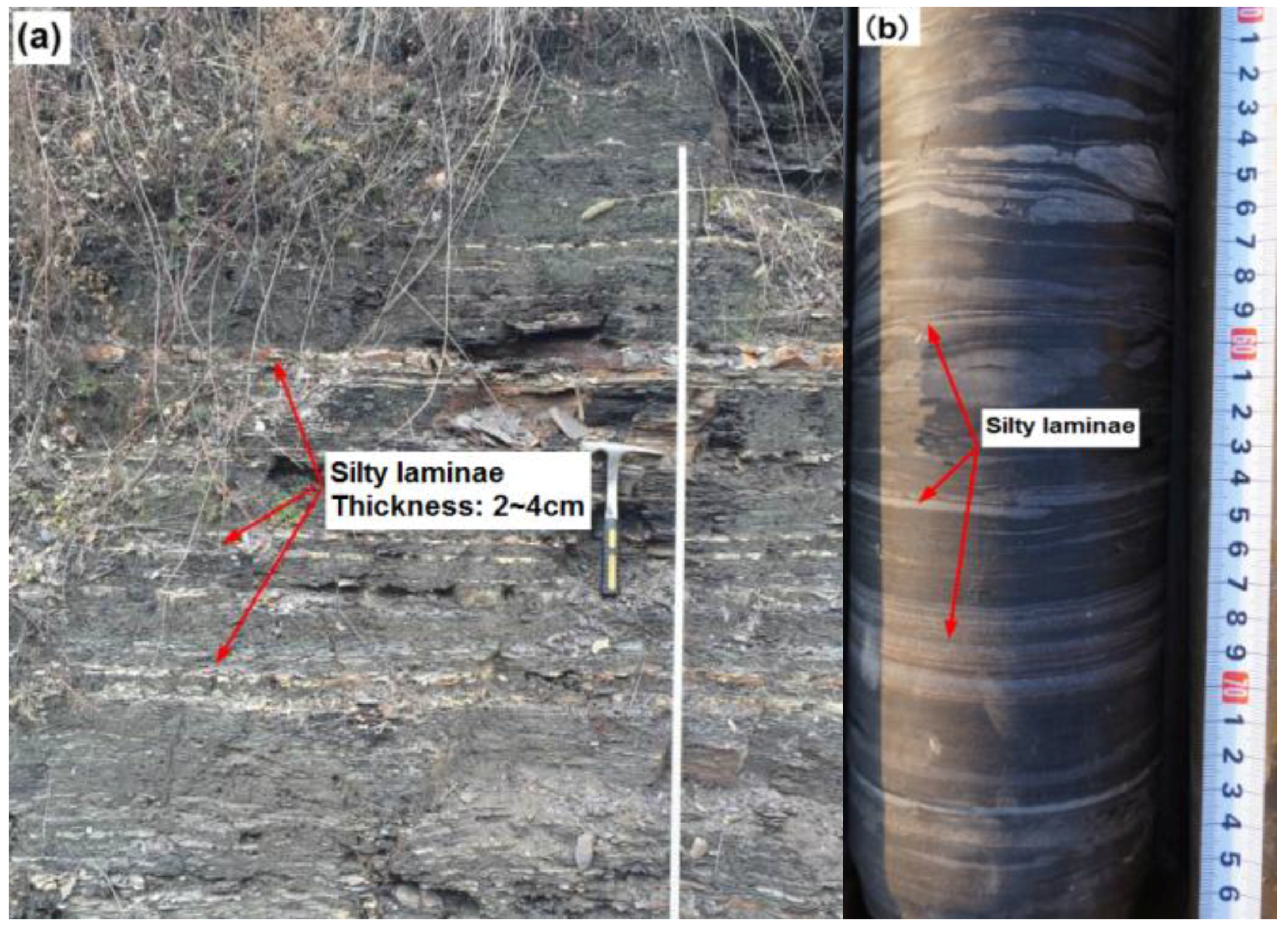

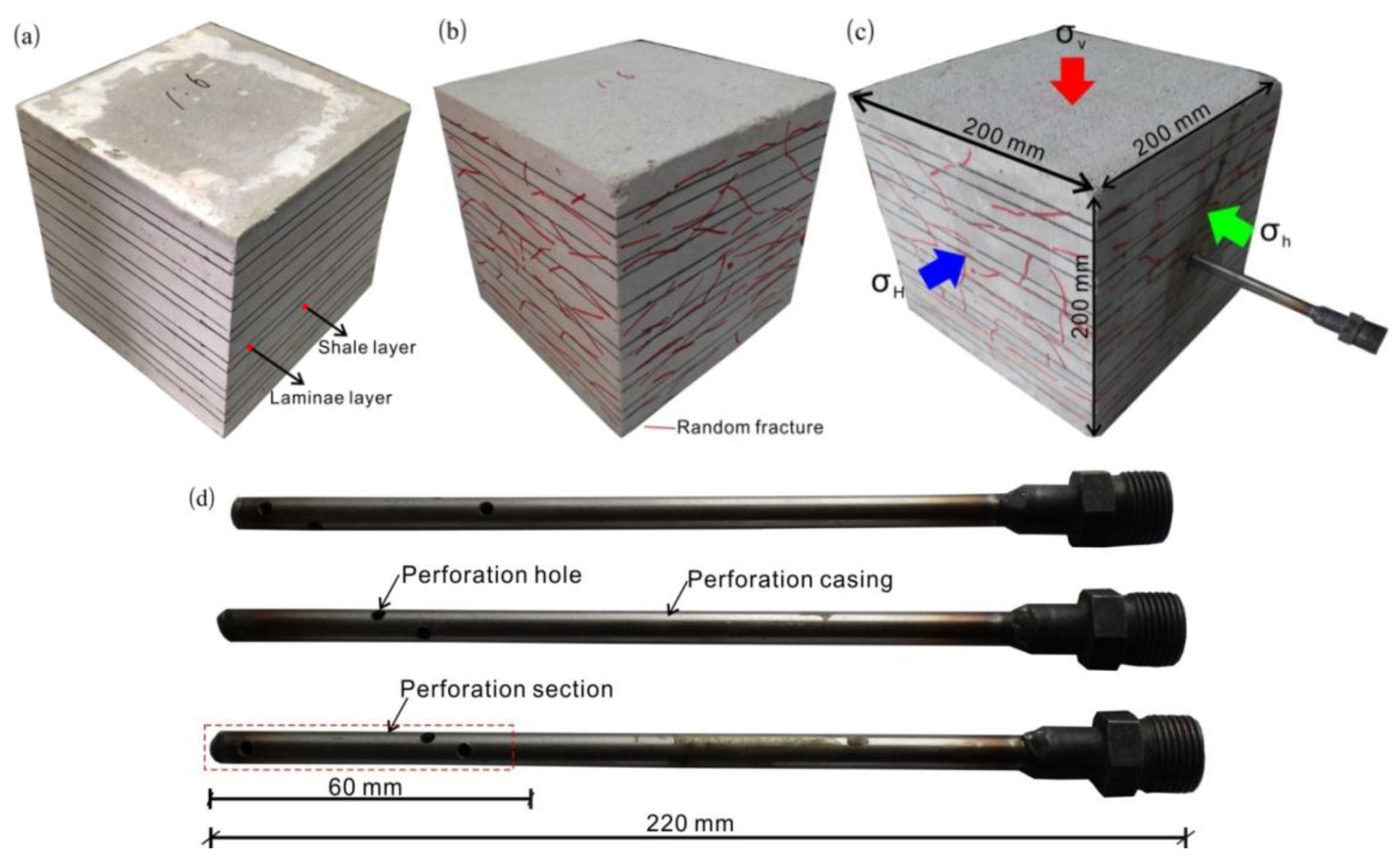
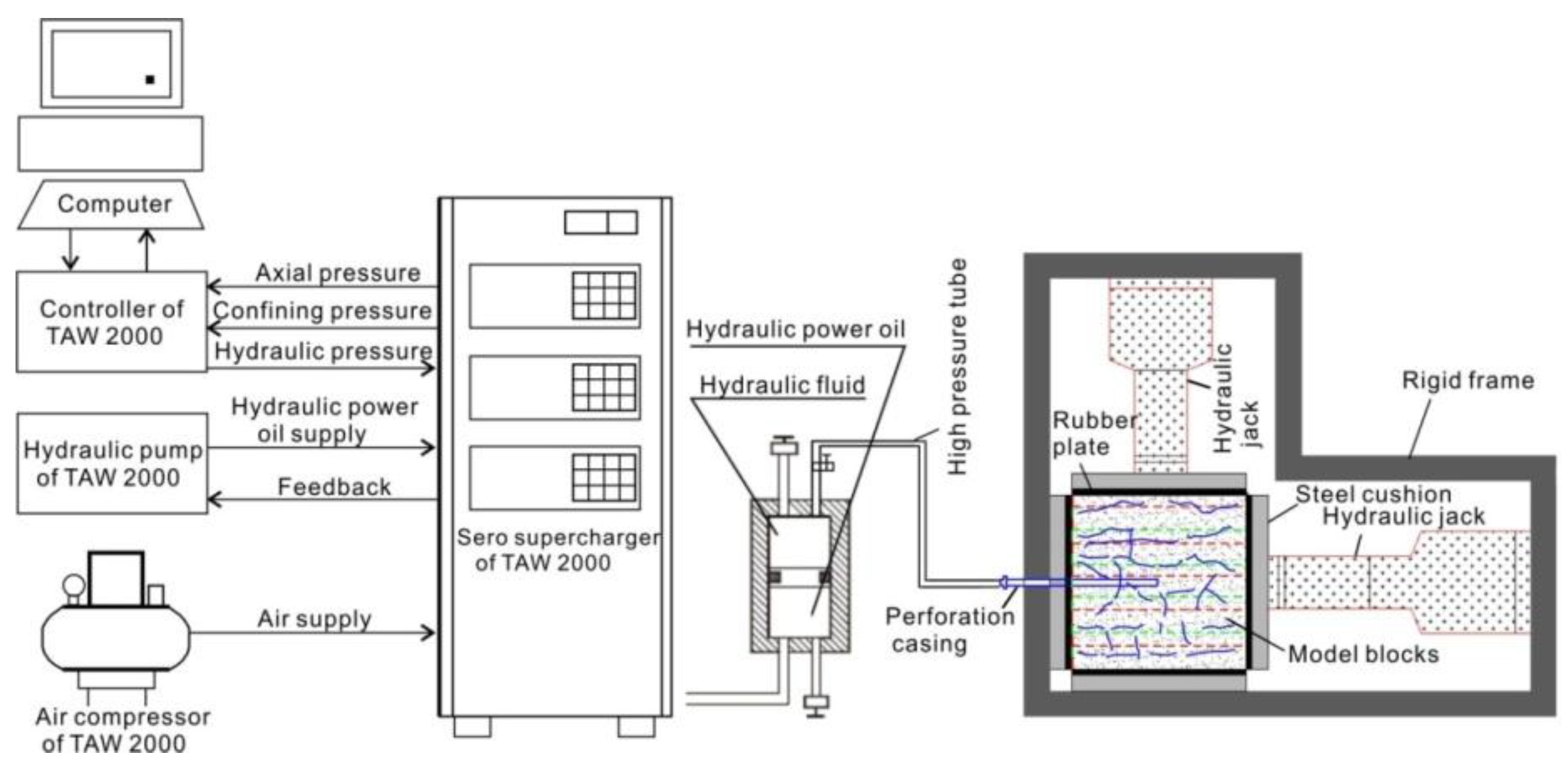


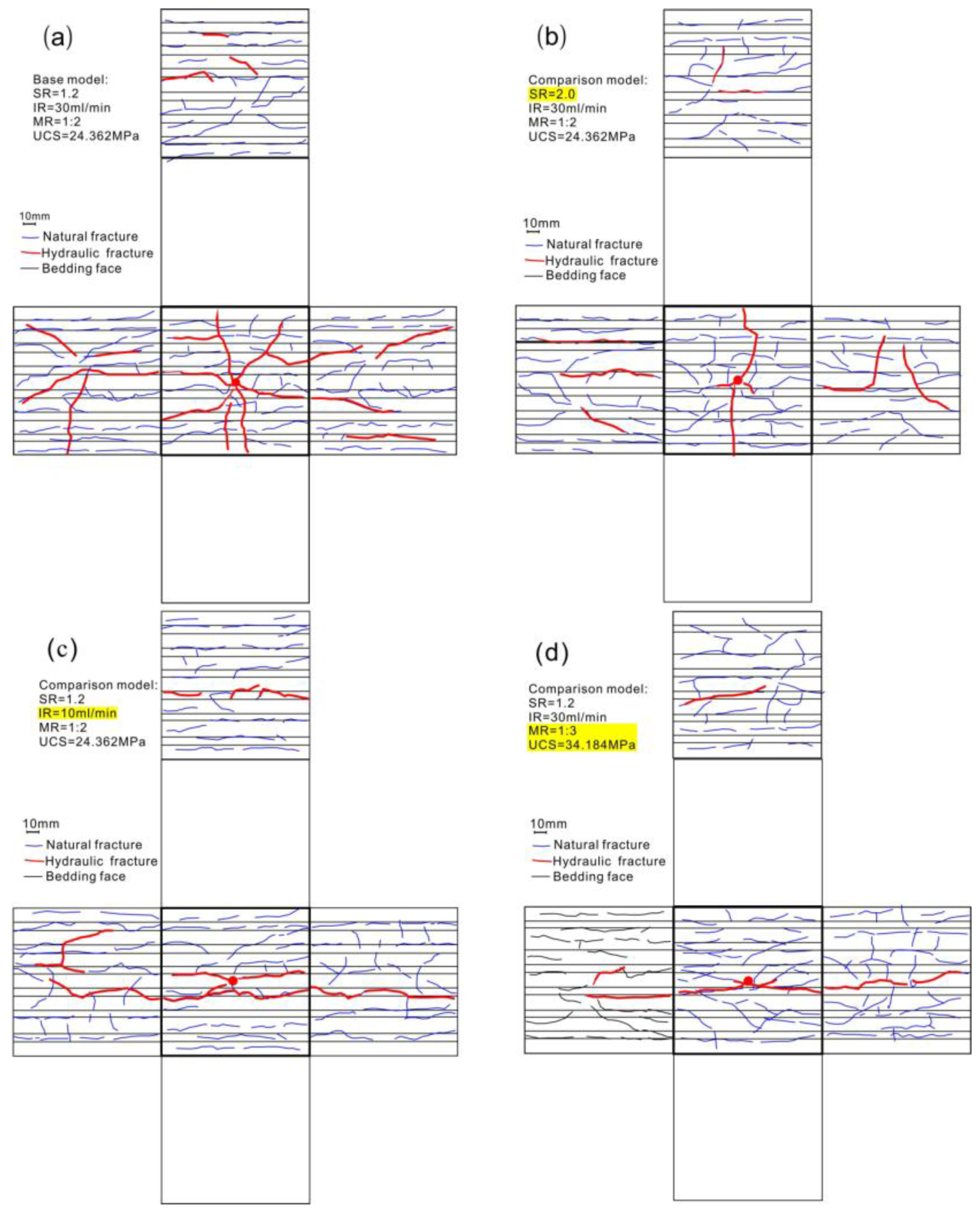
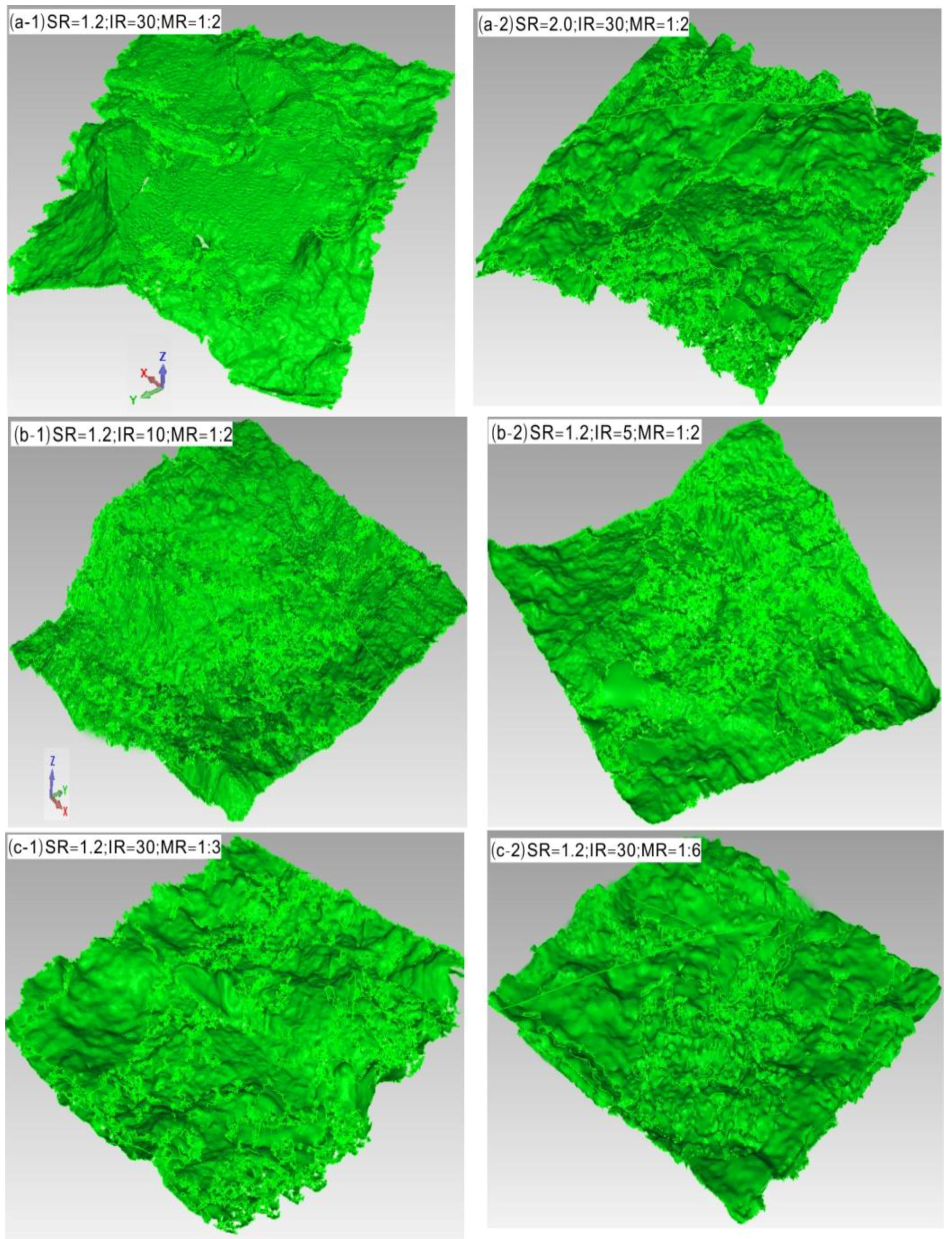
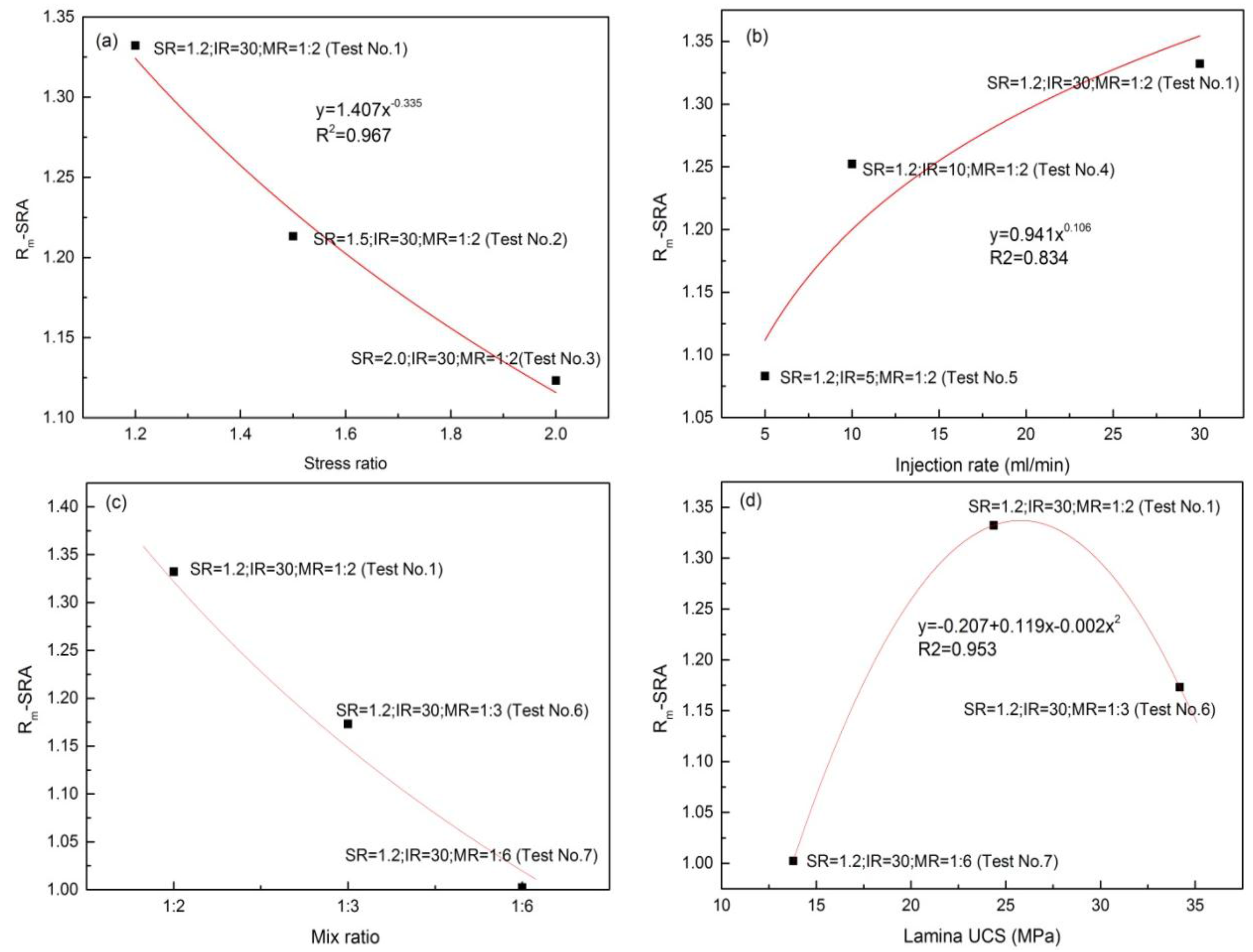
| Test No. | SR(/)a | IR(mL/min) b | Laminae Material | |
|---|---|---|---|---|
| MR(/)c | UCSd | |||
| 1 | 1.2 | 30 | 1:2 | 24.362 |
| 2 | 1.5 | 30 | 1:2 | 24.362 |
| 3 | 2.0 | 30 | 1:2 | 24.362 |
| 4 | 1.2 | 10 | 1:2 | 24.362 |
| 5 | 1.2 | 5 | 1:2 | 24.362 |
| 6 | 1.2 | 30 | 1:3 | 34.184 |
| 7 | 1.2 | 30 | 1:6 | 13.782 |
| Test No. | Rm(SRA)(/)e | Geometry Morphology Descriptions of Fracturing Network |
|---|---|---|
| 1 | 1.3322 | Radial random net-fractures |
| 2 | 1.2132 | Main vertical facture with partly branches |
| 3 | 1.1232 | Main vertical facture with partly branches |
| 4 | 1.3023 | Partly horizontal fracture with random branches |
| 5 | 1.0931 | Partly horizontal fracture with random branches |
| 6 | 1.1732 | Main vertical facture with partly branches |
| 7 | 1.0323 | Main horizontal fracture with partly fractures |
© 2016 by the authors; licensee MDPI, Basel, Switzerland. This article is an open access article distributed under the terms and conditions of the Creative Commons Attribution (CC-BY) license (http://creativecommons.org/licenses/by/4.0/).
Share and Cite
Wang, Y.; Li, X.; He, J.; Zhao, Z.; Zheng, B. Investigation of Fracturing Network Propagation in Random Naturally Fractured and Laminated Block Experiments. Energies 2016, 9, 588. https://doi.org/10.3390/en9080588
Wang Y, Li X, He J, Zhao Z, Zheng B. Investigation of Fracturing Network Propagation in Random Naturally Fractured and Laminated Block Experiments. Energies. 2016; 9(8):588. https://doi.org/10.3390/en9080588
Chicago/Turabian StyleWang, Yu, Xiao Li, Jianming He, Zhiheng Zhao, and Bo Zheng. 2016. "Investigation of Fracturing Network Propagation in Random Naturally Fractured and Laminated Block Experiments" Energies 9, no. 8: 588. https://doi.org/10.3390/en9080588






